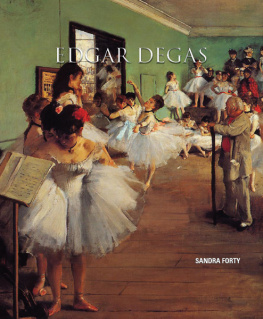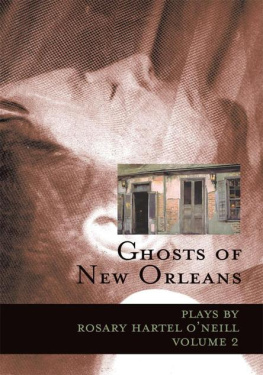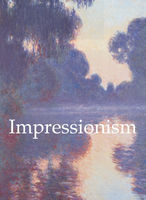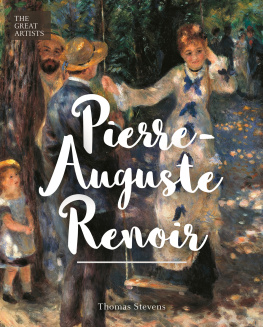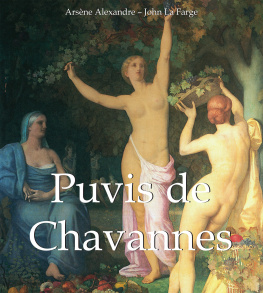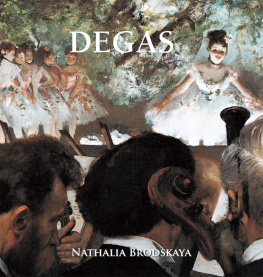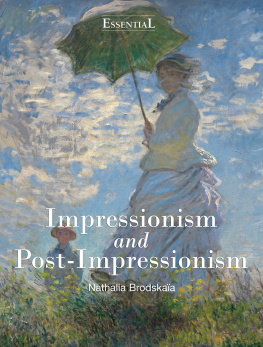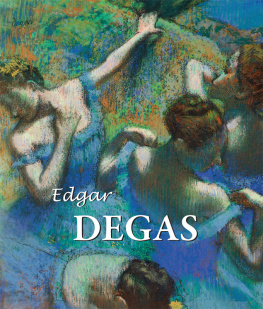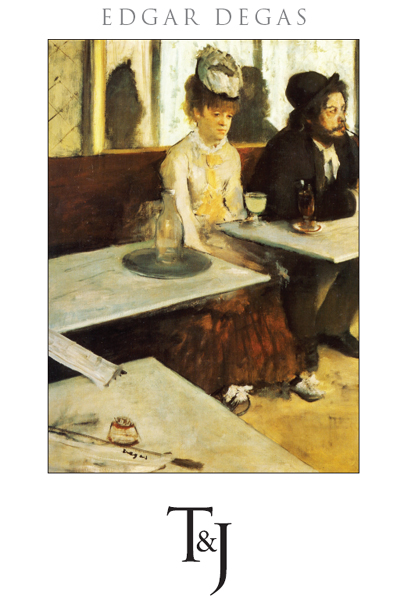
Published by TAJ Books International LLC 2013
219 Great Lake Drive
Cary, North Carolina, USA
27519
www.tajbooks.com
www.tajminibooks.com
Copyright TAJ Books International LLC
All rights reserved. No part of this publication may be reproduced, stored
in a retrieval system, or transmitted in any form or by any means, electronic,
mechanical, photocopying, recording, or otherwise, without the prior written
permission of the Publisher and copyright holders.
All notations of errors or omissions (author inquiries, permissions)
concerning the content of this book should be addressed to
.
eISBN 978-1-84406-237-9
PRINT ISBN: XXXXXXXXXXXXX
Printed in China.
1 2 3 4 5 17 16 15 14 13
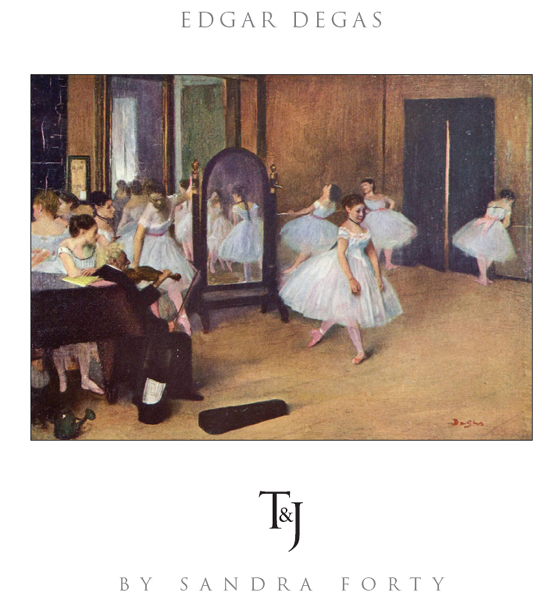
EDGAR DEGAS
18391917
Edgar Degas began as a classical painter of genre history scenes and died as one of the greatest and most innovative names in French artalthough as with so many other artists, he did not receive a great deal of recognition in his lifetime. Along the way his style changed completely from strict academic formalism to near-abstract scenes of contemporary Parisian life. His primary subject was the human form, especially that of women, and he also loved the vibrancy of horse racing.
Degas is usually labeled an Impressionist because he was friendly with many of the Impressionist painters and was a founder of the Impressionist movement, but he actually rejected the characterization and referred to his style as realism. He considered one of the Impressionists basic tenetspainting en plein airludicrous and only painted in a studio, using models for his figures or simply relying on his memory of a scene. Nevertheless, he did exhibit in seven of the eight Impressionist exhibitions.
Above all, Degas was a superb draftsman. This skill, coupled with his innovative eye, allowed him to generate an entirely new compositional approach to painting, making him one of the truly great recorders of ordinary lives. Once he found a subject, he would work at the composition repeatedly, calculating the angles and tones, and returning many times to the subject until he was satisfied with the result. In later life, he also became interested in photography, which helps explain why angles and viewpoints in his paintings became so innovative. The fresh view of the lens opened his artistic eye to intriguing new possibilities of perspective and apparently spontaneous composition.
Degas said, I know nothing of inspiration, spontaneity, temper; what I do is the result of a long reflection and a study of the great masters. His greatest artistic idol was Ingres, but he also admired the Italian Renaissance painters, as well as Velasquez, Goya, Poussin, and David. Although a classicist at heart and by training, Degas wanted to explore the possibilities of art and take it into new realms. This goal and vision he shared with the Impressionists: a desire to see in new ways. But he never wanted or intended to abandon what had gone before. He famously said, Ah, Giotto! Let me see Paris! And you, Parislet me see Giotto!
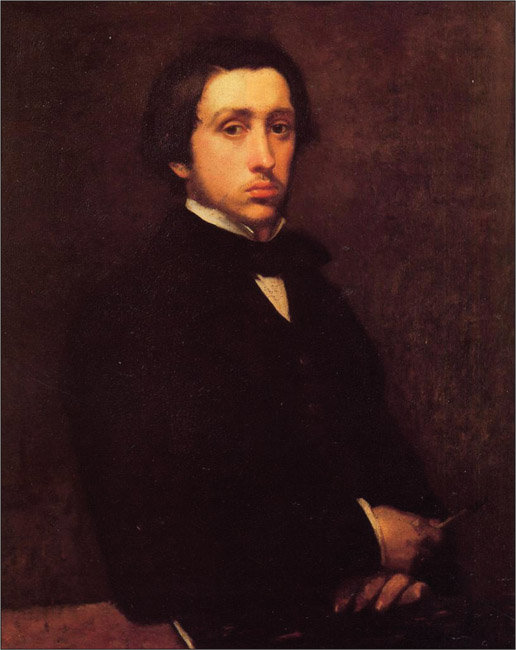
Self-portrait, 1855
All his life Degas was temperamental, restless, and easily provoked into bad temper. His impatient nature may explain the tremendous and intense output that he produced and also why so many of his works remained unfinished. In his early years, he had a comfortable private income and thus did not have to ingratiate himself to anyone.
Between 1873 and 1883, he concentrated on women working in the ballet and in cafs, women bathing nude, and dancers in the music halls as well as onlookers thronging the race track. Degas first went to the Paris Opera to see the ballet when he was over 40 years old, and for the next 30 years made the dancers his principal subjects and grand obsession. He is particularly remembered for his paintings of young ballet dancers. He rarely showed the public performance of the dance and instead depicted rehearsals, dance classes, costume fittings, the long waits between dancing, and the dance masters; in other words, he portrayed the boredom and the stress rather than the magic and the dazzle. That was what really intrigued to him. He wanted to show the strain behind the perfection. He became obsessed with the subject and in later years focused on ballet dancers again and again. When he was asked by an American collector, Why Monsieur, do you always do ballet dancers? he shot back, Because, Madame, it is all that is left us of the combined movements of the Greeks. In essence, the classical discipline of the dance had to be celebrated above all.
It wasnt the ballet itself that enthralled him, although he did love the art form, but rather dance was his way to distract and console himself from his own life. He was interested in the secrets that dancing bodies conveyed and the things dance portrayed about the human condition. He came to know the ballet well and annotated some of his sketches with the name of the position he was portraying.
Critics and his contemporary artists considered Degas distinctly eccentric and erratic, but he was indifferent to their scorn and criticism. Such social ineptness contributed to his lack of success, although some critics could see past his personal failings and admired his art. None of this was helped by his reluctance to show his work. He was a careful, deliberate artist, planning every aspect of composition and color. He said, If painting werent difficult, it wouldnt be so fun. After 1873 his eyesight increasingly let him down, so he turned to sculpture and working with pastels. It was only in later life that Degas achieved real success, and as with all too many artists, he was only really appreciated after his death.
Hilaire-Germain-Edgar de Gas, later known to the world as Edgar Degas, was born into an affluent and musical Parisian family on July 19, 1834. His mother, Clestine Musson, was a Creole from New Orleans and his father, Pierre August Hyacinthe de Gas, a Neapolitan banker and art lover. He had four younger siblings, Achille (1838), Thrse (1840), Marguerite (1842), and Ren (1845). Around 1860, Edgar changed his surname from the socially pretentious de Gas to the spelling he is known by today.
Degas artistic talent was apparent from a young age. His precocious ability to draw and paint was encouraged by his art-loving father. His family was also very musical, especially his mother who was an amateur opera singer. They even occasionally held recitals at their home.
A favorite occupation for father and son was to go to the Louvre, where they saw some of the worlds greatest paintings and were able to meet important people in the art world, people such as the eminent collector Paul Valpinon, who encouraged Degas interest in neoclassical painting. Nevertheless, Degas had a strict upbringing, and the strictures of classicism resonated with him, something reinforced by the strictly conventional, classically rigorous Lyce Louis-le-Grand in Paris that he attended from the age of 11.
Tragedy struck in 1847 when his mother Clestine died, leaving the family bereft. Degas was the oldest of her children, then at the age of 13. His grandfather stepped in to help his father look after the children.
At age 18 he was given permission by the Louvre to copy paintings in their collection. He also sketched numerous studies of the plaster casts of the horses from the Parthenon, laying the groundwork for his future horse paintings. While he was delighted with his sons artistic ability, his father wanted him to become a lawyer. So, to please his father, Degas started studying the law in November 1853 after earning a baccalaureate in literature. But his heart was not in the law. He wanted to be an artist. Ultimately, he did not apply himself to his legal studies, and by 1855, he had given the law up altogether.
Next page
